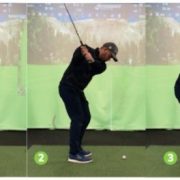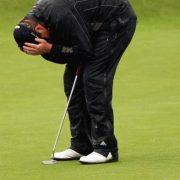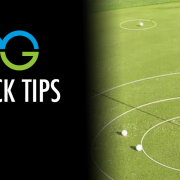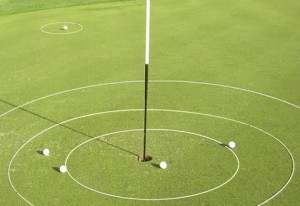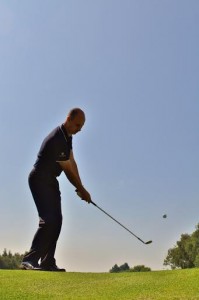Trying Too Hard

.
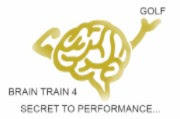
Last weekend I had the pleasure of playing in the final of the Taskers Bantoft Trophy along with my fellow team mates from Branston Golf & Country Club shown above with our caddies. We played a strong team from Whittington, making it an all Staffordshire final from 10 counties. It’s a fabulous competition for ladies over 50 (they also run a comp for men over 50 too) run as a knockout, with all proceeds from the event being given to junior golf development.
.

.
We played the final at a beautiful course, Wollaton Park in Nottinghamshire. 3 finals were held on the day the ladies and 2 gents trophies were up for grabs. It was comforting to have our caddies by our sides as we took to the first tee to be announced by the organiser Mike Crawford who sponsors the event.
The first 6 holes didn’t go according to plan, losing out on putting to my opponent, I found myself 4 holes down in matchplay. Along with my fellow team mates, I had played the course earlier in the week and had created a strategy using my yardage notebook. My son caddying for me shook his head and looked at me with disbelief and said “What are you doing, this is not your game, you’re trying too hard. Relax, slow down, your too tense”.
He was right, I was trying too hard. I had taken time to prepare myself before teeing off on the first so that I was not nervous, but my attention had become too tense that it was preventing me from playing. This can happen in the heat of competition, you try too hard and end up jeopardising your chances.
Scientifically what you’re doing is using your left side of the brain – the analytical side. In my case I was looking at my notes, analysing where my shot needed to be and stayed in the left-side of my brain when trying to hit the ball. What I needed to do, was switch to my mind to the right-side, the creative mind when standing over my ball to take the shot.
The most effective way to tap into your right-side, is by focusing on one of your senses, for some people this is visualisation, for others it can be feeling or listening to the sound of your ball strike. For me its about taping into feeling, its focusing on my tempo whilst making a swing or a putt. To activate this I also take a deep breathe in and exhale.
To my son’s delight I then went on a par rampage, dropping only 4 shots over 11 holes, pulling the match back to all square on the 18th, playing 5 shots under my handicap for the round. My opponent Janet played amazing golf, sinking incredible putts to keep the game alive. This meant we had to continue down the 19th hole to conclude our match. Finishing with yet another par and a shot in hand, secured my win. Our team went on to win 6-1 on the day, an incredible finish to a great season at Branston.
If you would like to learn more about these techniques please register for our upcoming event at Branston Golf and Country Club on November 2nd. The workshop starts at 7pm, costs £15 and includes a glass of wine. Places are limited, to reserve your spot click here
If you’re unable to make this event and would like one to be held at your club please contact me by clicking on this link carol.alford@
Hope you enjoyed this week’s blog, please do drop us an email and let us know what you think, we would love to hear from you. Why not visit our website
http://www.braintrain4.com/
How to combat your self destruct

You are your own worst enemy
Golf will beat you up, you don’t need to add to the beating!
Sometimes we forget why we play this beautiful game. I frequently see golfers on the course berating themselves for playing a bad a shot. Without realising it, they are actually doing more harm and wrecking any chance of performing at their best.
I’ve spoken in previous blogs about the importance of letting go, holding on to your frustration and anger is a recipe for disaster. I’ve been delving deeper into the effects of negative self-talk and thought you would be interested with some of my latest findings.
Memories are extremely important to us, we use them to encode, store and recall important information.
Whenever we do something in life, the experience we have will create a memory, whether it be good (positive) or bad (negative). The experience becomes imprinted and internally represented in specific areas in our brain, so that we can use them as reference points to help us face similar situations again or adapt to new ones. Our memories were created originally, to keep us safe and help us to survive from predators.
Now of course we don’t have to worry about being eaten alive by dinosaurs today, but our memories are there to still keep us safe.
Let me give you an example of how this works – As a small child if we touched something hot – say the oven door, we would experience both the physical feeling and emotional pain. To add to this drama it would no doubt be so traumatic, that it would make us cry too. Our brains would then store the association – hot oven door = pain as a memory.
The more emotionally charged the event or experience, the stronger the memory. What you may not be aware of is that bad (negative) memories are stored far quicker than good (positive) memories and they are 3X stronger!!!!
So lets relate this to our game of golf – when we hit a bad shot and go on to berate ourselves – the more stronger that emotion, the more powerful that memory is hot-wired into our brains. As we curse, kick our bag or throw our clubs around we are without knowing reinforcing that memory. So much so, that when we replay that hole or a hole similar to it, our body remembers what happened previously and reacts in the same way, and before we know it we’ve hit the same bad shot again – and so the circle continues!
So what should you do?
Well its impossible to tell yourself – don’t have negative thoughts – they are hardwired into our being. But what you can do, is when you have a negative thought don’t attach any emotion to it. Instead you have 2 options – you either attach a positive emotion or your remain objective.
So next time you hit a bad shot instead of cursing and throwing a tantrum, tell yourself that shot wasn’t good enough because (e.g. my swing was too quick, or my balance wasn’t where it needed to be). This will improve your performance for the rest of the game and will prevent that bad memory from surfacing next time you play that hole or one similar to it.
We are looking at running a workshop on emotions in November if you are interested please contact me for details by clicking here
Hope you enjoyed this week’s blog, please do drop us an email and let us know what you think, we would love to hear from you. Why not visit our website
http://www.braintrain4.com/
Release your caged tiger
.
I recently heard a fabulous analogy to describe how we typically train for golf that explains why we find ourselves struggling when playing in competition. 90% of coaching and training is carried out in a controlled environment, such as at a range or putting green. What we haven’t appreciated is that this is setting us to fail in competition, the reason why I’ll explain using the caged tiger story.
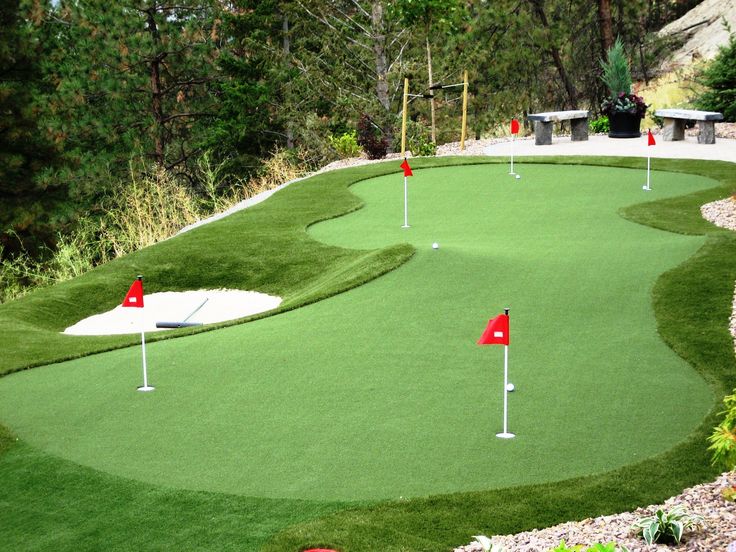
A tiger born in captivity grows up and develops in a safe environment. It is regularly feed and does not fear being attacked or killed by predators. Whereas a tiger born in its natural environment has to seek out its own food source, which might mean it goes for several days without food. It has to adapt to its ever changing environment, seeking shelter wherever it can and remain alert in order to survive being injured or killed.
If you were to take the tiger which has grown up in captivity, in the safety of a zoo and place it in the wild, the chances are it wouldn’t survive for long. Even though it is equipped with the same tools as its wild counterpart; sharp teeth, sense of smell, large claws and ability to pounce. It does not have the skills to deal with a changing environment, the talent to track and capture food or the ability to recognise danger and deal with a possible attack on its life.
So why should we be surprised that practising at the range, in a controlled environment should then equip us to perform well out on the course in competition? As we all know the course doesn’t provide flat lies. Instead we are faced with contours, hills, gusting wind, rough grass, rain, obstacles such as bunkers, water hazards and out of bounds. Like the caged tiger we are placed into a foreign environment and expected to perform at our best.
Yes like the two tigers described above we are equipped with the same tools, how to hold a club, set up and swing, but our lack of skills to deal with the changing environment means we too will struggle to survive. So to release your caged tiger you must change the way in which you practice to develop the skills you will require to succeed. That’s why your training programme should include practice out on the course and being creative with your shots to increase your skill set to enable you to take on the challenges faced in competition. It should also incorporated an element of competition to get the adrenaline kicking in.
If you would like more on how to train effectively book a session with me and lets develop a winning plan to release your caged tiger.
Hope you enjoyed this week’s blog, please do drop us an email and let us know what you think, we would love to hear from you. Why not visit our website
http://www.braintrain4.com/ an

How to cure the ‘Yips’
As a mental toughness coach, this is inevitably the most common request I get for help. I’ve seen people, literally at the point of giving up the game, due to the fear of embarrassment and frustration created by the Yips.
What are the yips?
Yips are every golfers nightmare. Being unable to control twitching in the hands and arms, leading to frustration and anxiety. Its most commonly seen in putting but can also affect chipping and driving too.
Yips can affect players of all ages and abilities, leaving the player in total misery. Ironically it tends to affect more competitive players who are used to playing well. Unlike the shanks, which is a flaw in the swing path, the yips is an emotional problem. This is why we find it so debilitating, it attacks our confidence and self esteem, striking fear into our soul.
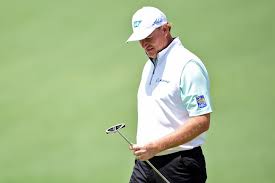
It attacks the pros on tour too. I’m sure you can all recall Ernie Els on the 1st green at The Masters last year.
Golfers have tried and failed to resolve the issue by changing their grip or even going to the extreme of purchasing a new club or putter. But of course none of this works, due to the fact that the yips is a mental problem. They may get a temporary resolve, but in reality, it’s a case of treating the symptom and not the route cause and over time the problem will inevitably return.
Brain Science
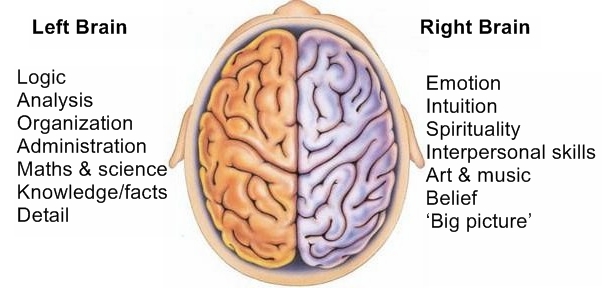
Our brains are complex pieces of machinery. They contain 2 hemispheres, left and right. The Left side is used for analysis and decision making whilst the right hand side is used for visualisation and creativity. When taking a shot the brain will use both hemispheres as part of the pre-shot routine, the left to analyse what club, distance and shot to make. Once the decision has been made the right hand side will kick in, using the eyes to visualise the shot. On taking the shot the left side will become quiet.
Facts about the Yips
When you have a case of the yips
– Your feel for the shot diminishes and is replaced with the desire to control.
– You become Outcome Focused, instead of Process Focused.
– Your subconscious mind is totally focused on ways to avoid the yips.
– Your eyes will move quite quickly or stare intensley for long periods
– Your left hand side of the brain will be dominant before and during your shot
Why is this a problem?
– When your focused on control your attention is on the outcome, rather than the process, resulting in your motor skills becoming less effective, i.e you loose “the feel”. We all know putting is about the” feel”. If you loose this ability, it becomes more difficult to gauge how hard or soft to hit the ball. Consequently your attention will turn to the mechanics of the swing, resulting in your left brain going into overdrive, analysing the shot. The longer you stand there, the more negative thoughts you will have. Some have likened this to being “paralysed with fear”.
This is exactly what happened to Kevin Na on tour with his driving. Other players would dread playing with him, as his thinking time over the drive was incredibly long. He would struggle to take the club head away from the ball, his over-thinking was preventing him from initiating his back swing. Numerous complaints about his slow play forced him to seek the advice of a mental coach to resolve his angst.
– When you are outcome focused your attention is tuned into how to prevent the yips instead of the target to hit. This creates numerous messages being sent to the brain which leave the muscles confused and not ready to execute the shot in hand. This lack of control creates the jerky movement of the Yip, removing any rhythm, tempo or timing.
– Your subconscious mind drives your body to perform, if it doesn’t receive clear messages its unable to perform at its best.
– When your eyes are moving rapidly several messages are sent to the brain, resulting in your muscles being unable to respond effectively and jerky movements follow.
– When your left hand side of the brain is dominant your decision process has not been completed and therefore continues to offer you “advice” through the execution of the swing. Unfortunately this impedes the use of the right hand side of the brain, which is required to help you visualise the shot to make and the target to hit. Without this working you will not make the shot you require or hit the target.
So What’s the cure?
To eliminate the yips you need to clearly define what’s causing them and then using mental toughness routines to quieten your mind before and during the shot.
As I previously mentioned Yips are mostly caused by emotion (70% by anxiety), in some cases they can be caused by poor technique. A lesson with your golf pro will eliminate any poor techniques in your swing or alignment.
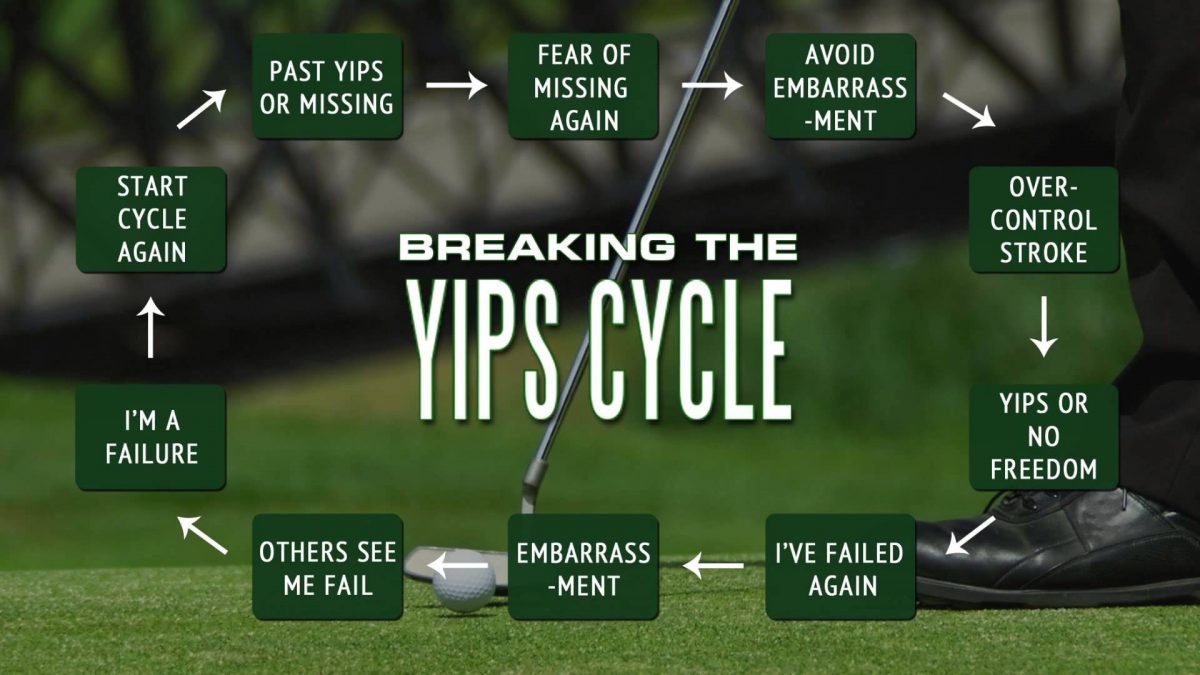
To resolve your emotional yips you really should seek the advice of a mental coach. A session will identify what’s creating the problem and how to resolve. Its all about breaking the cycle and creating new neural pathways in your brain. This will in time, make you become process focused, rather than internalising what you’ve done wrong and the mechanics required to take back control.
Every yip can attack your confidence and esteem resulting in performance anxiety attacks between shots. Don’t be held to ransom by them, get in touch with a mental toughness coach and resolve your issue, so that you can continue to enjoy this wonderful game.
My proven process has helped many golfers, remove their fear of embarrassment, anxiety and frustration. If you would like help with your yips please arrange a session with me by simply clicking here
Hope you enjoyed this week’s blog, please do drop us an email and let us know what you think, we would love to hear from you. Why not visit our website
http://www.braintrain4.com/
Carol Alford
BrainTrain4 – Course Management
Following on from our highly successful golf psychology evening last week at Branston G&CC in Staffs, there was one topic that appears to have resonated with several people. So this week, I’ve decided to dedicate the blog to course management to show how changing your thought process can have a dramatic effect.
.
Why should I consider Course Management?
Do you have a certain hole on your course that constantly gives you grief every time you play? It’s a common complaint I hear from many people. When I ask do they have the same result/problem every time they play it. Inevitably the answer is yes.
Too many amateur players fall into the trap of thinking they have to hit the ball as far as possible off the tee. When in reality, they should flip the thought process and start from the pin on the green and work backwards. Alison Nicholas last week shared with us that Annika Sorenstam would do this exercise as she could see how the hole had been designed by the architect. By walking towards the tee you are more able to see where the tee box aims towards. You might be surprised to find that golf architects quite often aim the tee away from the fairway (this might explain why some of your shots don’t go in the direction you anticipated).
.
What else can I learn by walking the course from pin to tee?
Start with considering what is your favourite distance to hit into the green. Which club are you most confident hitting and gives you better accuracy? Once you’ve discovered the distance and club now work your way back from that point. Each time selecting the next distance and club until you’ve worked your way back to the tee.
Lets show a worked example from when my daughter Emma played last year at St Andrews in the University Girls invitation. This is played over 3 days on 3 courses at St Andrews. My daughter played off 12 when she entered and played with two local girls from Scotland with handicaps of 5 and 6.
The hole shown below is the 14th on the Eden Course played on day 2 of the competition.

.
My daughter chose a safe option electing to take a 6 iron off the tee which landed centre of the fairway and short of the water hazard. This gave her a clear shot into the green with a 7 iron, which she pitched next to the pin, resulting in a birdie. The other two girls took drivers, one faded off to the right of the fairway and the other landed close to the water hazard on the left. They came off with a par and a boggy. My daughter had assessed the situation and felt more confident hitting an iron from the tee which played to her strength.
Using this tactic over the 3 days she was in contention, using her course management she avoided the pot bunkers and hazards. The only time she entered a bunker was on the penultimate hole, and the reason being she didn’t stick to her strategy. Lessons were learnt that week about using course management and the results were evident to see with a huge handicap cut to 8!
.
What should I also consider?
You need to take into account your personality. Some people play safe whilst others are risk takers. If you are a risk taker thats ok, but be aware of your limitations. Don’t take on shots that you haven’t practiced or not confident to execute.
.
Tip No.1
Know your club yardages. This removes doubt from your mind when making your club selection. Its easy to do, you can hit a number of balls with a club, measure with a device such as a Bushnell and take the average. Alternatively book a Trackman lesson.
.
Tip No.2
Record your rounds by making notes on clubs selected, where you landed and score taken. Recording your data will give you an insight into patterns occurring on the course and highlight where you need to focus your attention on course management.
.
Tip No.3
Create a map on each of your greens at your club. Note where the breaks and borrows are. Refer to your map before putting to confirm what you’ve seen visually when assessing your putt. The knowledge you learn playing your course over time is immense and having a map of the green to refer to will bring confidence to your putting.
I highly recommend the Mario Beky books, they are a handy size that fits snuggly into your back pocket. You can map both your fairway shots and greens and document your club yardages on the back of the book. A great reference guide. It’s like having a caddy in your pocket!
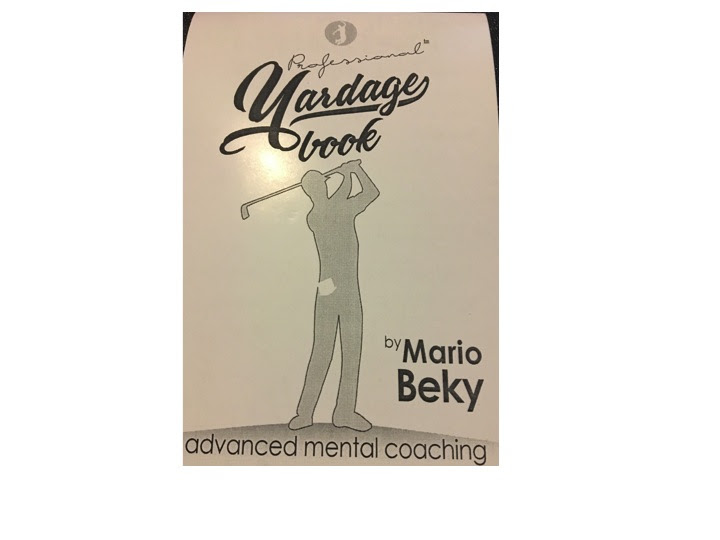
Hope you enjoyed this article, please do drop us an email and let us know what you think, we would love to hear from you. Visit our website
http://www.braintrain4.com/
Perfect Pitching
 Perfect Pitching
Perfect Pitching
David Fulcher – Quick tips
The short game is a very unstated area of the game, and one which we are all guilty of not practicing enough. Improving your short game can have a greater impact on lowering scores and improving your handicap without even changing your long game technique.
Question:
Do you know how many times you have had 100 yards or less into a green and taken 3 or less shots to complete the hole?
If the answer is no, over the next few rounds monitor how many times you score 3 or less from 100 yards, or vitally how many times you don’t! The aim is to ensure you don’t score 4 from 100 yards or less. 3 or better is the goal!
Here are a few ways to help lower your scores and pitch the ball closer to the hole.
The Landing Zone:
The landing zone is a very important element of pitching. Try to ensure you land the ball early onto the green and use the club selected to control how much the ball rolls. Too often too much loft is used, a sand wedge or lob wedge and most of the time you have to use a long swing to get the ball high and the distance required. This can cause problems with strike.
Club Selection:
Select a club which allows you to land the ball in the circle on the front of the green and use the club selection to let the ball roll out. This fulch1maybe a low lofted club such as a 7 or 8 iron. Practice with a variety of clubs and find out which club suits you best.
Come and sharpen your Short Game with David and the professional staff at Edgbaston Golf Club this summer to help lower your scores!
David is the Director of Golf and Head Pro at Edgbaston GC and an advanced PGA Professional. He has worked alongside some of the leading experts in the fields of physiotherapy, biomechanics and performance coaching.
David and the professional team can be contacted on 0121 4541736 or e-mail david@davidfulchergolf.co.uk
MIDLANDS GOLFER CONTACT NUMBERS
General Enquiries: 07883 188081
Email: editor@midlandsgolfer.co.uk




